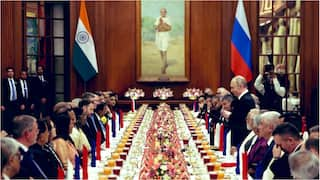Pairing Cheese, Chocolate With Wine Is A Match Made In Heaven. Know Why
Before matching wine with chocolate or cheese, it's crucial to take their respective flavours into account.

Two of the beautiful things in the world that give happiness in its own unique way are wine with cheese or chocolate. Thereby, combining them can yield the most delightful experience, enhancing the flavours of beverages and sweets to their fullest potential. But before matching wine with either of them, it's crucial to take their respective flavours into account.
Pairing Wine With Chocolate:
According to Chef Arvind Prasad, who is the Co-Founder, Executive Pastry chef and Academic Director Whitecaps International School of Pastry, "Chocolate is the third rail of food-wine pairings, and comparing wine to chocolate can elicit strong reactions, from categorical statements that the two don't belong together to unexpected love songs or memorable dinners. Thinking of chocolate as the most challenging wine match, rather than the most demanding wine pairing, may be more subjective."
"Generally, the wine should have a higher sugar content than the dessert. However, excellent chocolate has a bitter aftertaste, further complicating the pairing," he added.
In addition, hge shared the following tips when it comes to pairing wine with chocolate:
- Make sugar with sugar:
When it comes to wine and chocolate combinations, it's better to stay away from opposites, unlike most other pairings, when finding a balance is essential. Bitter chocolates, like black chocolate, pair better with drier wines, while sweeter chocolates, like white chocolate, pair better with sweeter wines. Consider it similar to matching sugar to sugar. Bitter dark chocolate goes well with dry wines that have very little residual sugar, whereas sweet white chocolate combines well with sweet wines that have a lot of residual sugar. Always choose wines that complement chocolate by having a sweetness level that is either the same or slightly higher than the chocolate itself.
- Equalise the intensity of the two.
It's essential to match intensity in addition to sugar. Any subtlety that may have been present in the chocolate will be completely overwhelmed by the power of the red when paired with a thick, full-bodied dark chocolate. Conversely, a delicate wine will be ruined by strong-tasting chocolate. Remember that powerfully flavoured chocolates work best with rich wines, while light-flavoured chocolates are best when combined with light-bodied wines.
- Blend tastes together
Similar flavour notes in chocolate can be evoked by wine and vice versa. Some chocolates, for example, pair exceptionally well with fruity wines, such as a Moscato or a White Zinfandel, because they are naturally more fruity than others. Savour chocolate-covered almonds with a nutty wine, such as a Marsala or Madeira. It's essential to keep this in mind when mixing truffles with wine.
Considering wine as a component is the best course of approach. You may discover wine's affinities with other dishes by dissecting it into its fundamental flavours and subtle nuances. You may "season" the flavours in your meal match by using, for instance, the faint undertones of cinnamon and 5-spice powder that Zinfandel frequently displays. A perfect wine pairing aims to bring out the delicate aromas and flavours in the food and wine by balancing their tastes (sweet, sour, bitter, salty, etc.).
Pairing Wine With Cheese:
Talking about this, Manoj Pandey, who is the Chef Partner at The Piano Man said, "Pairing wine and cheese is a process that requires careful planning for a balanced flavour experience. Choosing subtly flavoured foods is crucial to let the unique profiles of both wine and cheese shine. Wines, being naturally acidic, often pair well with salty cheeses, creating a delightful taste combination. To achieve this harmony, include simple yet complementary elements like crackers, artisanal flatbreads, fresh fruits, nuts, and olives. These food items act as mediators, bridging the gap between the acidic and salty notes, resulting in a refined and enjoyable culinary experience."
Other Things To Keep In Mind While Pairing Wine And Food:
Amrit Kiran Singh, who is the Former Executive Chairman of the International Spirits and Wines Association of India said, "The food and wine on your menu should include as many different taste sensations as possible to avoid culinary boredom."
He further listed the following:
- There are two and a half aspects of a wine that you should consider while matching food and wine. First, it's acidity and sweetness. Secondly, it's texture - creamy, silky, watery or rough. And finally, to a lesser extent, the aroma.
- Remember, the food on your plate does not have to taste like the wine in your glass! Instead, it is so much more interesting to plan appealing contrasts. Chicken Kababs , Fish Tikka and salads , for example go well with light acidic whites (riesling, sauvignon blancs).
- Young, light, fruity reds such as Nouveau Beaujolais or Rose' wines that have not absorbed much of the tannins go well with sausages, pizzas and even a gentle Lucknow Biryani.
- Luxurious velvety reds such as Merlots and Zinfandels go well with spicy Indian Roghan Josh and yes the Hyderabadi biryani, which is spicy.
- Spatlese(late harvest) wines that have high glucose content as a result make for great dessert wines but are tricky when it comes to pairing with food.
- However, they generally go well with Asian foods (Thai & Indian curries) whose spiciness should be kept away from acidic wines and also biscuit based desserts.






































